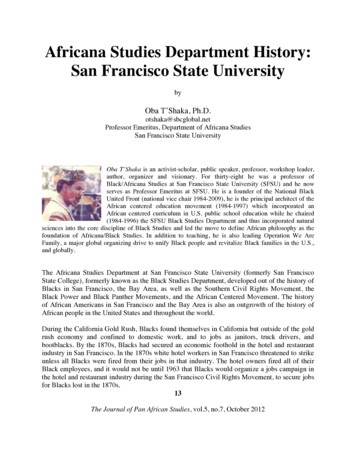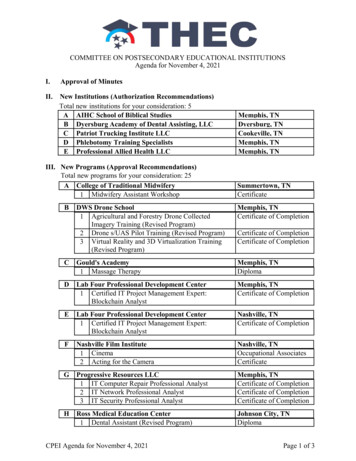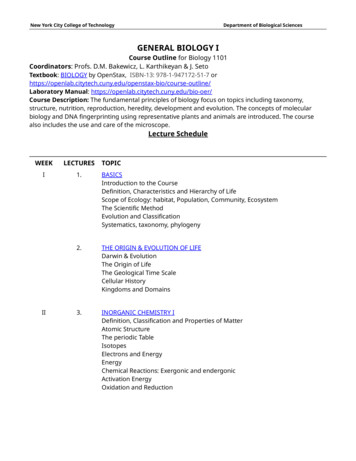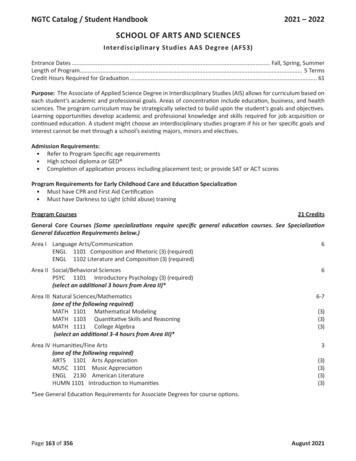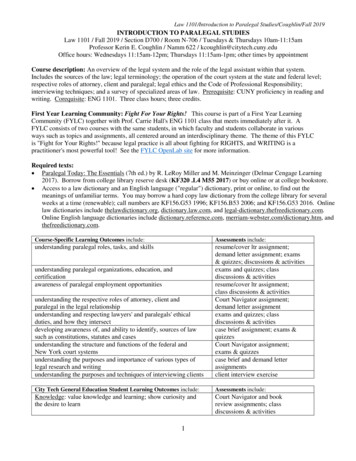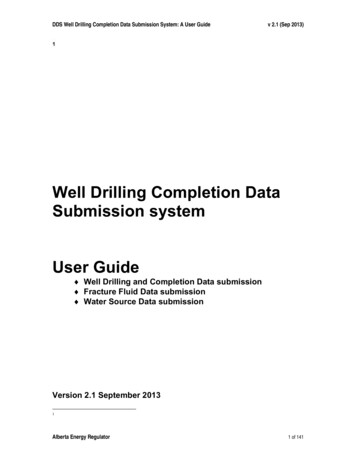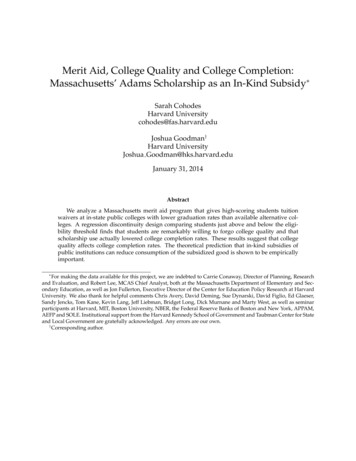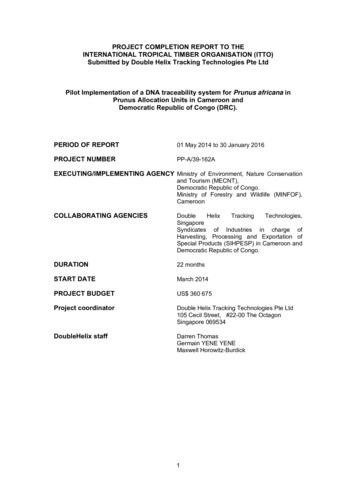
Transcription
PROJECT COMPLETION REPORT TO THEINTERNATIONAL TROPICAL TIMBER ORGANISATION (ITTO)Submitted by Double Helix Tracking Technologies Pte LtdPilot Implementation of a DNA traceability system for Prunus africana inPrunus Allocation Units in Cameroon andDemocratic Republic of Congo (DRC).PERIOD OF REPORT01 May 2014 to 30 January 2016PROJECT NUMBERPP-A/39-162AEXECUTING/IMPLEMENTING AGENCY Ministry of Environment, Nature Conservationand Tourism (MECNT),Democratic Republic of Congo.Ministry of Forestry and Wildlife (MINFOF),CameroonCOLLABORATING yndicates of Industries in charge ofHarvesting, Processing and Exportation ofSpecial Products (SIHPESP) in Cameroon andDemocratic Republic of Congo.DURATION22 monthsSTART DATEMarch 2014PROJECT BUDGETUS 360 675Project coordinatorDouble Helix Tracking Technologies Pte Ltd105 Cecil Street, #22-00 The OctagonSingapore 069534DoubleHelix staffDarren ThomasGermain YENE YENEMaxwell Horowitz-Burdick1
Table of ContentsEXECUTIVE SUMMARY314PROJECT IDENTIFICATION1.1Context41.2Origin and problem42PROJECT OBJECTIVES AND IMPLEMENTATION STRATEGY52.1Objectives and adjustments52.2Implementation strategy and adjustments52.3Risks and assumptions6PROJECT PERFORMANCE733.1Achievement of project outputs and activities3.2Comparison of activity progress against schedule113.3Project expenditure against funds input114PROJECT OUTCOME7124.1Tangible outputs124.2Participation of target beneficiaries134.3Next steps135LESSONS LEARNED / DIFFICULTIES ENCOUNTERED146CONCLUSIONS AND RECOMMENDATIONS16References18APPENDIX A: DNA EXTRACTION REPORT19APPENDIX B: FINAL LAB REPORT FROM THÜNEN INSTITUTE22APPENDIX C: LIST OF PROJECT STAKEHOLDER MEETINGS30APPENDIX D: DNA VERIFICATION SYSTEM DESIGN31APPENDIX E: FINANCIAL REPORT362
EXECUTIVE SUMMARYThis project is the latest in a series supported by the ITTO focusing on the development ofDNA techniques for timber traceability. It provides a real study of impact on forest and sawmilloperations and shows that the likely running costs of such a system is a small percentage ofproduct value.The ITTO-CITES project coordination team have been evaluating tracking systems that canprovide reliable identification of products produced in concessions/forests where improvedmanagement standards have been implemented and the non-detriment findings required byCITES to allow legal exports have been undertaken. This pilot project was selected to showthat DNA verification can detect and deter substitution or addition of Prunus bark from nonauthorised sources, and increase supply chain transparency. Through this approach it ishoped that an increase in export quotas can be considered based on scientific data thatprovides hard evidence of secure supply chains.The original project objective was to implement an effective DNA-based traceability systemthat would allow Prunus africana bark to be traced back to specific trees from controlledPAUs. Mid-way through the project in March 2015, a change to the scope of work wasrequested based on a better understanding of ground operations and operational limitations inDRC. The approved change meant that additional work could be undertaken to developtraceability back to distinct populations (or geographic areas) of Prunus, as well as toindividual trees. This work was conducted at no extra cost to ITTO.All project outputs and activities were successfully carried out, including additional samplingand laboratory activities required under the expanded scope of work. The project durationwas extended from 18 to 22 months to allow for the additional work, and also due to initialdelays in sampling, delays in issuance of CITES permits for scientific samples andimpounding of samples by customs authorities.Tangible outputs from the project include a suite of 16 genetic markers that can be used toassign samples back to both individual trees and populations (distinct geographic regionssuch as PAUs or harvest zones) with a high degree of confidence. Genetic reference data for8 Prunus populations has been developed which can be utilized for traceability purposes.Raw genetic sequence data generated by this project can also be used to support otherresearch efforts such as landscape reconstruction or climate change adaptation for thespecies. A comprehensive DNA verification system has also been designed that allows forroutine verification of CITES permit applications, export permits and import permits.Key lessons learnt were in relation to improving field sampling practices to avoid errors incollection and sample recording. It is also now clear that population assignment is a moreuseful technique to apply where chain-of-custody procedures are either non-existent orlacking. However assignment of bark to individual trees is viable in areas such as MountCameroon, where good chain of custody procedures already exist. Many difficulties wereencountered with the existing CITES permit application process and shipment of samples,even as part of this scientific exercise.This project has proven that randomly selected samples can be matched back to a PAU orharvest zone of origin, or an individual tree if necessary. A DNA verification system has beenproposed that can verify claims of origin on CITES export and import permits to be applied atmultiple ‘control points’ along the Prunus supply chain. Before it can be implemented, it isstrongly recommended that a review of the CITES permit process is undertaken to increasethe speed of approval for scientific samples, otherwise routine testing and reporting of resultswill be too slow.In future, further genetic reference data can be easily established for other PAUs and harvestzones that would enable blanket coverage of all authorized Prunus exploitation and securethe trade in sustainably harvested Prunus bark. The same approach can be applied tosafeguard the sustainability of other CITES listed tree species around the world.3
1PROJECT IDENTIFICATION1.1 ContextThis project was carried out at the request of the ITTO to support the ITTO-CITES program“CITES implementation for tree species and trade/market transparency (TMT).” Within theprogramme, the project supports the ITTO–CITES Component expected output (e) “Improvedcapacity for the installation of modern, effective information and tracking systems” as well asthe TMT component. The project is consistent with both DRC’s and Cameroon’s Forestpolicies.The project is the latest in a series supported by the ITTO focusing on the development ofDNA techniques for timber traceability. Such systems were first introduced by Double HelixTracking Technologies Pte Ltd (DoubleHelix) in the Indonesian forestry sector in 2007,designed to verify Chain-of-Custody documentation of merbau (Intsia spp.), processed forexport to Australia, New Zealand and Europe and supported by ITTO through Activity No.:PP-A/43-194 - Promote Trade in Tropical Timber and Tropical Timber Products fromSustainably Managed and Legally Harvested Sources). Project results have been publishedin the peer-reviewed scientific journal Silvae Genetica1 and a recent ITTO-CITES publication2.Other ITTO funded DNA projects have included PD 620/11 Development and Implementationof a Species Identification and Timber Tracking System in Africa with DNA Fingerprints andStable Isotopes, which involved genetic mapping of multiple tree species across sevencountries in Africa.This project is therefore the latest to demonstrate the practical application of DNA technologyand its real-world implementation. It offers a real study of impact on forest and sawmilloperations and demonstrates that the likely running costs of such a system is a smallpercentage of the final Prunus product value.1.2 Origin and problemThe ITTO-CITES project coordination team had been looking for tracking systems that canprovide reliable identification of products produced in concessions/forests where improvedmanagement standards have been implemented and the non-detriment findings required byCITES to allow legal exports have been undertaken.Suspected Prunus exports from non-project areas trying to pass off as from better managedareas or trying to piggy-back on quotas established and approved for the better managedareas added further impetus to the implementation of this project.It is hoped that through the successful implementation and roll out of this project, bettermonitoring of controlled sustainable Prunus supply chains will lead to an increase in supplychain transparency and confidence, allowing for an increase in export quotas to beconsidered based on scientific data that provides evidence of secure supply chains.4
2PROJECT OBJECTIVES AND IMPLEMENTATION STRATEGY2.1 Objectives and adjustmentsThe original project objective was to implement an effective DNA-based traceability systemthat would allow Prunus africana bark to be traced back to specific trees from controlledPAUs.The proposed DNA traceability system would enable random verification of traceabilitydocumentation and CITES export/imports permits to detect bark substitution fromuncontrolled areas and associated document fraud to a high level of confidence, allowing fortimely corrective actions to be implemented.AdjustmentsMid-way through the project in March 2015, a change to the scope of work was requestedbased on a better understanding of ground operations and operational limitations in DRC.Due to difficulties in bark segregation in DRC and ongoing security concerns, DoubleHelixrecommended adjusting the proposed system to allow for traceability back to distinct Prunuspopulations (PAUs or harvest zones), rather than to individual trees. Whilst we would nolonger be aiming to identify the specific tree that a piece of bark came from, we would be ableto identify and verify that bark came from the claimed PAUs or harvest zones. This capabilitywould still enable independent, scientific verification of CITES export permit applications.2.2 Implementation strategy and adjustmentsThe implementation strategy consisted of:Preparation and development of DNA reference data Preliminary work to confirm the ability to extract DNA from Prunus bark. If unsuccessful,this would have been a severely limiting factor to successful project completion. In parallel with the above, we worked to train sampling teams in both Cameroon and DRCin proper procedures for sample collection, recording, storage and shipment. This trainingwas combined with the opening workshops, with practical field trips conducted in the daysfollowing the workshops in both countries. After training, an initial round of sampling of Prunus from standing trees in differentpopulations in Cameroon and DRC was conducted by the sampling teams. These samples were sent to the Thünen Institute for analysis and development of geneticmarkers (a process call ‘genotyping’) that enables discrimination between different treesof the same species.Field implementation Further discussion and research was conducted into Prunus harvesting, transportationand processing activities, in order to build knowledge that would inform the developmentof the DNA-based verification system. The basis of the system is simple: apply DNAtesting to verify and validate claims of origin of harvest in CITES export and importpermits. A field implementation stage was planned to determine how samples could be takenduring actual harvest and processing operations. At this point we determined that in DRC,bark is mixed too early in the process to maintain segregation between trees. Thisprompted a change in approach to population assignment rather than individual treeassignment.5
DNA testing and analysis Final DNA testing and statistical analysis was then conducted at the Thünen Institute inGermany to determine the effectiveness of the approach to assign samples taken fromwarehouses and processing facilities back to PAUs and harvest zones.2.3 Risks and assumptionsThe key risk identified during the proposal phase was security in East DRC. At the time theGovernment of DRC had recently negotiated a peace deal with rebels in the north and SouthKivu, allowing for field work to take place. Sampling in this area was in fact disrupted, with abatch of bark samples confiscated by local militia, and repeat sampling undertaken.A further risk was possible problems of DNA extraction from Prunus bark which would requireadditional efforts to develop genetic markers. This risk was mitigated through a trial DNAextraction activity at the beginning of the project, and successful analysis against existinggenetic markers of Prunus persica.Assumptions were made that there would be no problems associated with the transportationof bark samples from Cameroon and DRC to the laboratory in Germany, or with existingharvest and processing procedures that would allow for document matching of bark back toindividual trees.6
3PROJECT PERFORMANCEBased on the performance levels detailed below and presentation of project deliverables,DoubleHelix considers the project objective of building the capability to trace Prunus africanabark back to specific PAUs or harvest zones to a high level of confidence to be achieved.With the adjustment to the scope of work, the original objective has been exceeded,considering it is now possible to assign samples back to both individual trees and populations.Either approach can now be applied, depending on which approach is practical in eachcountry or supply chain.3.1 Achievement of project outputs and activitiesThere was some variation between the original planned outputs and activities which resultedin the successful completion of the project. A comparison between the project outputs andactivities as originally devised and the final outcomes follows:Output 1.1: Development of genetic markers for Prunus africana suitable for DNAfingerprinting of bark (differentiation of bark between individual trees of the samespecies).Activity 1.1.1 Trial DNA extraction from bark samplesProjectdocumentdescriptionInitial tests will be performed on Prunus africana bark samples toconfirm that DNA of sufficient quality and quantity can be extracted frombark on a routine basis.Changes toactivityRealized activityNoneComplete. A preliminary test to verify that DNA can be extracted from P.africana bark was successfully completed. Five samples were submittedto the laboratory for testing and DNA of sufficient quantity and qualitywas extracted from all five. The results of this DNA extraction test ispresented in Appendix A.Activity 1.1.2 Population samplingProjectdocumentdescriptionTwo hundred (200) samples will be collected from a number of differentpopulations within the species range. Twenty (20) samples each from 5different populations across Cameroon and another 5 differentpopulations in DRC will be collected.Changes toactivityThis activity was extended with additional collections in DRC to buildcapability for assignment to population as well as individual matching.Realized activityComplete. A total of 600 samples were collected across fourpopulations in Cameroon and five populations in DRC. There wasunclear geographic separation between collections in Cameroon andDRC, and these populations were therefore combined. It is likely thishappened due to incorrect recording of sample coordinates.In addition, a population from Kenya was included in the geneticanalysis to provide further comparison between populations.For more detail on the sample quantities and locations, refer toAppendix B. DNA sample records were provided in the mid-termproject report delivered December 2014.7
Activity 1.1.3 Genetic marker developmentProjectdocumentdescriptionThe samples from the above populations will be processed in thelaboratory to identify ‘polymorphic’ genetic markers. These are markersthat can be used to differentiate between individual trees of the samespecies.Changes toactivityWhilst the number of markers to be developed was not specified in theoriginal project description, it was decided to increase the number ofmarkers developed from 10 to 15 in order to build capability forpopulation assignment.Realized activityComplete. A total of 36 different Prunus SSR markers (31 nuclear and 5chloroplast SSR markers) were tested for amplification and segregationin the available Prunus africana populations. 16 markers (15 nuclearand 1 chloroplast SSR markers) were used in the final analysis.Based on these markers, it was possible to identify 9 distinct Prunusafricana populations from the samples submitted. All populations fromCameroon form one genetic cluster and all populations from East-Africa(DRC Kenya) form another cluster. Of interest is that the fourpopulations from Cameroon are split into two distinct genetic groups.The two populations (Cam Pop1 and Cam Pop4) in the South-West ofCameroon are very different from all the other populations.For more detail on the marker analysis, refer to Appendix B.Output 1.2: Capacity building and training of local teams in DNA sample collection andstorage.Activity 1.2.1 Workshops for stakeholder consultation and field trainingProjectdocumentdescriptionWe recommend an opening and closing workshop to inform, receiveinput and report back to key stakeholders involved in the ITTO-CITESproject.Suggested participant organisations include trade companyrepresentatives in Cameroon and DRC, government representatives,customs representatives and international buyers of Prunus bark.Changes toactivityRealized activityThe opening workshop will include a field trip to conduct training of staffin bark sampling techniques and can also be combined with thepopulation sampling (Activity 1.1.2).To save costs, we recommended combining workshops with the similarPericopsis elata project.Two opening workshops completed. Closing workshop completed inYaounde, Cameroon on 2 Feb 2016, with a further closing workshop inDRC planned for March 2016.In Cameroon we were able to combine the workshop and training forboth P. elata and Prunus africana projects. Agendas, attendance listsand photographs from the workshops have been provided in the midterm project report delivered December 2014.8
Output 1.3: Implementation of DNA verification in two controlled PAUs in Cameroonand DRC from pre-harvest to the factory and then to the exit points.Activity 1.3.1 Verification system developmentProjectdocumentdescriptionThis consists of identifying appropriate stages in the forestmanagement, harvesting and transportation process to take samplesfrom standing trees and bark.Care will be taken to work with concession and the national ITTOCITES project coordination teams to understand the field processes anddesign a sampling system that uses existing resources with minimumimpact on forest, transport and processing operations.Changes toactivityRealized activityAt the end of this stage a report will be presented explaining the systemdesign, statistical sampling strategy and resulting estimated level ofconfidence. (For example, “through this system we will be able to detectbark substitution amounting to 1% of total volume, 99% of the time”).No changeComplete. A number of phone calls and meetings have been held withmembers of ITTO, ANAFOR, MINFOF, MECNT and industry andacademic stakeholders. See Appendix C for a list of stakeholdermeetings held during the project.Final recommendations for a DNA-based verification system arepresented in Appendix D and are to be discussed in detail at theclosing meetings.Activity 1.3.2 Field implementationProjectdocumentdescriptionThe following basic process will be adapted according to the researchand findings made during Activity 1.3.1 Verification systemdevelopment.i)ii)iii)iv)Wood samples are taken from the cambium (the layer underneaththe bark of the tree) of Prunus africana trees either prior to harvestor during harvest.A second set of samples are taken from bark after harvest at anappropriate control point. Control points under consideration couldbe one or more of i) PAU exit gate ii) community drying or storageareas, iii) on delivery to processing facilities, iv) prior to loadingonto trucks for transport to the factories, v) at the port prior toexport or vi) on arrival at destination processing facilities inEurope.Using CoC documentation, the samples taken pre- and postharvest are physically matched together.A statistically representative number of paired samples areselected and sent to the DoubleHelix laboratory for DNA testing.The number of paired samples to be tested and the frequency of testingwill depend on the harvest plan and volume of timber harvested in eachperiod as well as the preferred timescales to identify problems andimplement corrective actions. DoubleHelix has previously applied ISO2859: Sampling procedures for inspection by attributes to calculate thenumber of samples to be tested according to the level of confidencerequired. A similar approach will be considered for this project.9
Changes toactivityThis has changed significantly due to the change in work scope towardpopulation analysis. Paired sampling and testing was conducted on aportion of samples in Cameroon and DRC. Another set of samples fromCameroon, DRC and Kenya were tested and assigned to population.Realized activitySamples for individual assignment were taken from one site inCameroon (AFRIMED), consisting of 55 pairs of cambium and bark, anda site in DRC (KAHINDO) consisting of 150 pairs of cambium and bark.Of these, 30 pairs from Cameroon and 60 pairs from DRC were tested.All remaining samples were collected from PAUs and harvest zones inDRC to be tested and assigned to population. For further detail, seeAppendix B.Activity 1.3.3 Ongoing DNA testingProjectdocumentdescriptionThe remainder of the DNA verification process is conducted in thelaboratory and does not impact forest operations.After DNA is extracted from the wood and bark samples, it is analysedand the genetic markers compared. If the DNA test confirms a geneticmatch between the paired samples, the chain-of-custody is provenintact. A genetic mis-match indicates that the paired samples come fromdifferent trees. This is evidence of substitution and further action can betaken.Changes toactivityThis activity was expanded to include both testing for individualassignment and population assignment.Realized activityBoth individual and population assignment tests were completed.Individual assignment revealed difficulties in successfully matchingmaterials from bark back to tree. Population assignment wascomparatively easy and more successful (see Activity 1.3.4). For furtherdetail see Appendix B.Activity 1.3.4 Statistical analysis of resultsProjectdocumentdescriptionA full analysis of the results of all the paired samples will be conductedand a final conclusion drawn on the likelihood of systematic substitutionwithin the supply chain. The test results and statistical analysis will beprovided in a report delivered regularly according to the frequency oftesting selected.Changes toactivityThis activity was expanded to include analysis of both individualassignment and population assignment.Realized activityIndividual assignmentThe practical test with material processed at a mill in Cameroon showeda high level of mis-match between results and chain of custody recordsof bark from individual trees. Thus we recommend focusing furtherapplications on verification of the population of harvest.Population assignmentGenetic differences between populations are highly significant and thesuccess of assignment back to the correct population was achieved witha mean average of 95%.For further detail see Appendix B.10
3.2 Comparison of activity progress against scheduleTable 2 below shows the project implementation in comparison with the detailed workplanprovided to ITTO in May 2014 and revised in March 2015. The approved workplan scheduleis marked in grey, with the actual implementation indicated by the hatched red cells.Table 2: Activity schedule in comparison with workplanOUTPUTS /ACTIVITIESRESPONSIBLE MayPARTY2014 JunMonthJanJul Aug Sep Oct Nov Dec 2015 Feb Mar Apr May JunJanJul Aug Sep Oct Nov Dec 2016 FebOutput 1.11.1.1 Trial DNAextractionDoubleHelix1.1.2 PopulationsamplingMECNT,ANAFOR,DoubleHelix1.1.3 DNA markerDoubleHelixdevelopmentOutput 1.21.2.1 Workshopsand trainingMECNT,ANAFOR,DoubleHelixOutput 1.31.3.1 VerificationsystemdevelopmentDoubleHelix1.3.2 FieldimplementationMECNT,ANAFOR,DoubleHelix1.3.3 OngoingDNA verificationDoubleHelix1.3.4 StatisticalanalysisDoubleHelix3.3 Project expenditure against funds input Total project expenditure to date by DoubleHelix: USD 223,716This figure consists:ooUSD 177,930 of direct expensesUSD 45,786 of project coordination and reporting costsThis figure does not include estimated expenses for attendance at the proposed projectclosing meeting in DRC in March 2016.The increased expenditure reflects the expansion in the scope of work and extension ofproject duration from 18 to 22 months. The additional cost has been absorbed by DoubleHelixat no charge to ITTO. For further detail on expenditure against budget (original and revised),see Appendix E. Total funds received from ITTO to date: USD 160,000 Remaining funds to be released: USD 36,10011
4PROJECT OUTCOMEThe objective of building capability to trace Prunus africana bark back to specific PAUs orharvest zones to a high level of confidence has been realised. The approach implemented inthis pilot project can be expanded to other authorized PAUs and harvest zones as part ofefforts to control and support the sustainable harvest and trade in Prunus bark.Attempts to sample and match Prunus bark from warehousing and processing facilities backto specific trees were challenging, even in cases where it was possible to segregate bark fromdifferent trees during harvest and transport.It is fortunate therefore, that the scope of work was adjusted to allow an implementation ofpopulation assignment to take place. Table 3 below clearly illustrates the effectiveness of thisapproach, where on average 95% of samples were assigned to the correct population.Table 3: Results of the self-assignment of individuals. The yellow cells mark thepercentage of correctly assigned individualsThere was some significant challenges to be overcome during the course of the project, whichis described in detail in Section 5.4.1 Tangible outputsA suite of genetic markers36 different Prunus SSR markers (31 nuclear and 5 chloroplast SSR markers) have beendeveloped, with 16 of them (15 nuclear and 1 chloroplast) used for the final project analysis.These markers can be used for both individual assignment (matching of bark back toindividual trees, as well as population assignment (matching of bark back to a geographicarea). As well as their utility for bark traceability, these markers have many other potentialresearch applications as described below.Genetic reference data for 8 distinct Prunus populations across Cameroon and DRCFor the first time, genetic profiles have been created for specific regions of Prunus africana.The data generated has an extremely long lifetime and will be valid for traceability purposesfor generations to come. The raw sequence data generated during this project can be sharedwith other research institutes and scientists for other analysis such as landscapereconstruction and climate change adaptation.12
Recommendations for a system to support verification of CITES applications, export andimport permits.As described in Appendix D, DoubleHelix has proposed a DNA verification system that canbe used to verify the accuracy of CITES export permit applications and the export/importpermits themselves at key control points in the supply chain.As forest management practices develop in PAUs and harvest zones under the ITTO-CITESprogramme, the DNA verification system can be adapted to monitor improvements in theevolving document chain of custody requirements.4.2 Participation of target beneficiaries Training of sampling teams in Cameroon and DRC on sampling techniques, samplepacking, storage and logistics. Participants in the training included those from localacademic institutions, universities, Government departments and Prunus exploitationindustry. Participation of industry in sampling process at PAUs and warehouse/distribution centres. Ongoing communication with Prunus exporters in DRC and importers in the EU. Discussion with CITES authorities on potential implementation of systems in Cameroon.Refer to Appendix C for details on meetings with stakeholders describing participationin the project.4.3 Next stepsAt the request of the European Commission SRG, a paper has been prepared by DoubleHelixon recommended activities to follow on from this project.In order for a traceability system to be of full benefit, it must be applied to the total coveragearea of Prunus exploitation. Our recommendations include: Peer review and publication of the scientific genetic marker development work. Additional sampling and marker development to enlarge the genetic reference databaseto include an additional 15 PAUs and harvest zones across the region. Formalisation of the procedures for sampling, testing and reporting in consultation withGovernment, the CITES Secretariat, industry and other stakeholders. The roll out of a screening programme (routine verification of CITES permits) to controlrisk of substitution from non-authorised areas, as described in Appendix D. Create a fast-track CITES permit issuing system for scientific samples to ensure speed ofdelivery of test samples from Cameroon and DRC to laboratories. Develop capacity to conduct testing within the region. As part of the ITTO Congo Basinproject, basic lab facilities have been set up with varying success in Kenya, Ghana andGabon. A proposal was submitted to ITTO in September 2014 for the creation of alaboratory in Cameroon.Note that the challenges of setting up a lab should not be underestimated. Once facilitiesand equipment have been installed, significant
Pilot Implementation of a DNA traceability system for Prunus africana in Prunus Allocation Units in Cameroon and Democratic Republic of Congo (DRC). . Project coordinator Double Helix Tracking Technologies Pte Ltd 105 Cecil Street, #22-00 The Octagon . Due to difficulties in bark segregation in DRC and ongoing security concerns, DoubleHelix .

